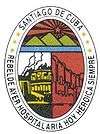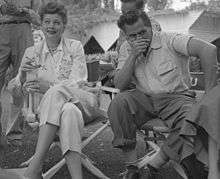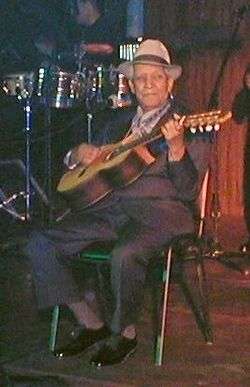Santiago de Cuba
| Santiago de Cuba | ||
|---|---|---|
| City | ||
 | ||
| ||
| Motto(s): Rebels yesterday, hospitable today, always heroic | ||
.png) Santiago municipality (red) within Santiago Province (yellow) and Cuba | ||
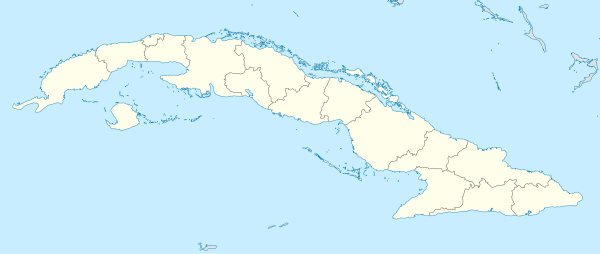 Santiago de Cuba Location of Santiago de Cuba in Cuba | ||
| Coordinates: 20°01′11.4″N 75°48′50.1″W / 20.019833°N 75.813917°WCoordinates: 20°01′11.4″N 75°48′50.1″W / 20.019833°N 75.813917°W | ||
| Country | Cuba | |
| Province | Santiago de Cuba | |
| Established | 1515 | |
| Founded by | Diego Velázquez de Cuéllar | |
| Area | ||
| • Municipality | 1,023.8 km2 (395.3 sq mi) | |
| Elevation | 82 m (269 ft) | |
| Population (2015)[1] | ||
| • City | 1,056,355 | |
| • Urban | 305,827 | |
| • Metro | 750,528 | |
| Demonym(s) | santiaguero/a | |
| Area code(s) | +53 22 | |
| Website | http://www.santiago.cu/ | |
Santiago de Cuba is the second-largest city of Cuba and the capital city of Santiago de Cuba Province. It lies in the southeastern area of the island, some 870 km (540 mi) southeast of the Cuban capital of Havana.
The municipality extends over 1,023.8 square kilometers (395.3 sq mi),[2] and contains the communities of Antonio Maceo, Bravo, Castillo Duany, Daiquirí, El Caney, El Cobre, El Cristo,[3] Guilera, Leyte Vidal, Moncada and Siboney.[4]
Historically Santiago de Cuba has long been the second-most important city on the island after Havana, and still remains the second-largest. It is on a bay connected to the Caribbean Sea and is an important sea port. In the 2012 population census the city of Santiago de Cuba recorded a population of 431,272 people.[1]
History
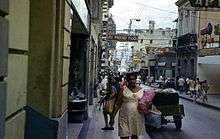
Santiago de Cuba was the fifth village founded by Spanish conquistador Diego Velázquez de Cuéllar on July 25, 1515. The settlement was destroyed by fire in 1516, and was immediately rebuilt. This was the starting point of the expeditions led by Juan de Grijalba and Hernán Cortés to the coasts of Mexico in 1518, and in 1538 by Hernando de Soto's expedition to Florida. The first cathedral was built in the city in 1528. From 1522 until 1589, Santiago was the capital of the Spanish colony of Cuba.
The city was plundered by French forces in 1553, by British forces in 1603 and again in 1662 under Christopher Myngs.
The city experienced an influx of French and British immigrants in the late 18th and early 19th centuries, many coming from Haiti after the Haitian slave revolt of 1791. This added to the city's eclectic cultural mix, already rich with Spanish and African culture.
It was also the location where Spanish troops faced their main defeat at San Juan Hill on July 1, 1898, during the Spanish–American War. After capturing the surrounding hills, General William Rufus Shafter laid siege to the city.[5] Spain later surrendered to the United States after Admiral William T. Sampson destroyed the Spanish Atlantic fleet just outside Santiago's harbor on July 3, 1898.[5][6]
José Martí, a Cuban poet, writer, and national hero, is buried in Santa Ifigenia Cemetery.
Role in the Cuban Revolution
Santiago was also the home of the revolutionary hero Frank País. On July 26, 1953, the Cuban Revolution began with an ill-prepared armed attack on the Moncada Barracks by a small contingent of rebels led by Fidel Castro. Shortly after this disastrous incident, País began talking with students and young working people informally, drawing around him what became an extremely effective urban revolutionary alliance. This developed into highly organized cells, coordinating a large-scale urban resistance that became instrumental in the success of the Cuban Revolution.[7]
País' group prepared carefully, accruing weapons, collecting money, collecting medical supplies. They published a cheap newsletter that reported news that criticized the government, attempting to counter Batista's censorship.[8]
In the summer of 1955, País' organization merged with Castro's July 26 Movement. País became the leader of the new organization in Oriente province, though two years later he was betrayed to the police and was shot after his capture.
On January 1, 1959, Fidel Castro proclaimed the victory of the Cuban Revolution from a balcony on Santiago de Cuba's city hall. His ashes are buried in the same cemetery as Marti's.
Culture
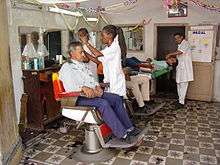
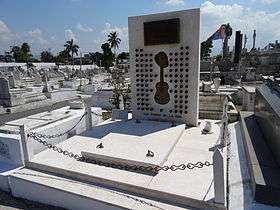
Santiago de Cuba was the hometown of poet José María Heredia. It is the birthplace of the world-famous Bacardi brand, which was started by Facundo Bacardi Masso in 1862. It now houses a museum that displays the extensive art collection of the Bacardí family.
Santiago de Cuba is well-known for its cultural life. Some of Cuba's most famous musicians, including Compay Segundo, Ibrahim Ferrer and Eliades Ochoa (all of whom participated in the Buena Vista Social Club) and trova composer Ñico Saquito (Benito Antonio Fernández Ortiz) were born in the city or in one of the villages surrounding it. They have contributed to the typical, country-like music of the city.
Furthermore, Santiago de Cuba is well known for its traditional dances, most notably son, from which salsa has been derived, and guaguancó, which is accompanied by percussion music only. The city is also well known for its Carnival, always celebrated in July, which is the reason Castro chose July 26 to enter undetected into the city to assault the Moncada Barracks. During Carnival, traditional conga music is played in the streets on a traditional pentatonic trumpet, called the trompeta china.
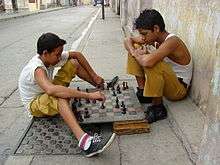
A relatively high number of residents of the city adhere to Afro-Cuban religions, most notably santería. The city hosts an important community of descendants of Haitian immigrants from the 19th century. Some aspects of the religious "vodún" heritage of the city can be traced back to this community.
In the city there are multiple architectural styles, from Baroque to neoclassical. Of special interest are the wooded parks, the steep streets, colonial buildings with huge windows and crowded balconies. Preserved historical treasures include the first home in the Americas, the first cathedral in Cuba, Cobre mine, the first copper mine opened in the Americas, and the first Cuban museum.
World Heritage Site
The local citadel of San Pedro de la Roca is inscribed on the UNESCO World Heritage List as "the most complete, best-preserved example of Spanish-American military architecture, based on Italian and Renaissance design principles".[9]
World Heritage Biosphere Reserve
The Baconao Park was inscribed on the UNESCO World Heritage Biosphere Reserve List in 1987.[10]
Geography
Santiago de Cuba is located in the southeast of the island at coordinates 20° 01' 17.42" N 75° 49' 45.75" W, some 870 km (540 mi) of the capital, Havana. Historically Santiago de Cuba has been the second-largest city in Cuba, behind Havana. It features a bay connected to the Caribbean Sea and is a major port. The municipality of Santiago de Cuba, where is its capital city, is the most populated of Cuba.
The city has been growing at the bottom of the bay and is surrounded on land by the Sierra Maestra. This determines the hot and humid climate of the place, the landscapes features rich composition of urban elements, natural and marine at the same time. It has an irregular offset, which contributed to the development of an urban setting where the avenues and streets are steep or descend.
Climate
Under the Köppen climate classification, Santiago de Cuba has a tropical savanna climate with no significant wet and dry periods through the year.
| Climate data for Santiago de Cuba | |||||||||||||
|---|---|---|---|---|---|---|---|---|---|---|---|---|---|
| Month | Jan | Feb | Mar | Apr | May | Jun | Jul | Aug | Sep | Oct | Nov | Dec | Year |
| Average high °C (°F) | 28 (82) |
28 (82) |
28 (82) |
28 (82) |
28 (82) |
29 (84) |
31 (88) |
31 (88) |
31 (88) |
30 (86) |
30 (86) |
30 (86) |
29 (85) |
| Average low °C (°F) | 21 (70) |
21 (70) |
22 (72) |
23 (73) |
23 (73) |
24 (75) |
25 (77) |
25 (77) |
24 (75) |
24 (75) |
23 (73) |
22 (72) |
23 (74) |
| Average precipitation mm (inches) | 73.7 (2.902) |
43.2 (1.701) |
53.3 (2.098) |
58.4 (2.299) |
139.7 (5.5) |
101.6 (4) |
68.6 (2.701) |
94 (3.7) |
106.7 (4.201) |
193 (7.6) |
94 (3.7) |
81.3 (3.201) |
1,107.5 (43.603) |
| Source: weather.com[11] | |||||||||||||
Demographics
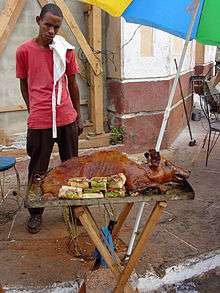
In the 2012 population census the city of Santiago de Cuba recorded a population of 431,272 people.[1]
| 1861 | 1899 | 1907 | 1919 | 1931 | 1943 | 1953 | ||||
|---|---|---|---|---|---|---|---|---|---|---|
| 36,752 | 43,090 | 45,470 | 62,083 | 101,508 | 118,266 | 163,237 | ||||
| 1970 | 1981 | 2002 | 2012 | |||||||
| 277,600 | 347,279 | 423,392 | 431,272 | |||||||
| All figures are census figures. | ||||||||||
Transportation
Santiago is served by Antonio Maceo Airport. Cubana de Aviación connects the city with Havana, Montréal, Port Au Prince, Santo Domingo, and Toronto with other airlines connects other cities in the Caribbean and North America.
The public transit in the city, like Havana, is carried out by two divisions, Omnibus Metropolitanos (OM) and Metrobus.[12] The Metrobus serves the inner-city urban area, with a maximum distance of 20 km (12 mi).[12] Omnibus Metropolitanos (OM) connects the adjacent towns and municipalities in the metropolitan area with the city center, with a maximum distance of 40 km (25 mi).[12]
Ferrocarriles de Cuba railways and ASTRO inter-city buses connect the city with Havana's Central Railway Station and with most other main cities of Cuba. The main railway station, also known as "General Senén Casas", is an important hub of the national railways. Located in the city centre, near the harbour, this was completely rebuilt in 1997.[13]
The city of Santiago is also crossed by the Carretera Central highway and by the southern section of the A1 motorway, largely unbuilt, that will link it with Havana as for the final project.
Schools
The main tertiary education institution is the University of Santiago de Cuba (Universidad de Oriente - Santiago de Cuba, UO).
Natives and residents
- Desi Arnaz - television/film actor, producer and bandleader
- Emilio Bacardí - industrialist and philanthropist
- Eusebia Cosme - declamdora negra, actress
- Orestes Destrade - professional baseball player
- Emilio Estefan - music producer and husband of singer Gloria Estefan
- Silvina Fabars - National Dance Award recipient of 2014 and principal dancer of the Conjunto Folclórico Nacional
- Ibrahim Ferrer - musician
- Sindo Garay - musician
- José María Heredia y Heredia - poet
- Pancho Herrera- professional baseball player
- Alberto Juantorena - Olympic gold medallist, 1976 Olympics
- Faizon Love - television/film actor, comedian
- Konnan - professional wrestler
- Olga Guillot - singer
- Paul Lafargue - journalist, literary critic, political writer and activist
- La Lupe - salsa singer
- Antonio Maceo Grajales - independence hero
- Rita Marley - singer and wife of reggae singer Bob Marley
- José Martí - independence hero; interred in Santiago de Cuba
- Miguel Matamoros - musician
- Eliades Ochoa - musician
- Frank Pais - revolutionary and urban organizer for the 26th of July Movement
- Richard Pérez-Peña - New York Times reporter
- Jorge Reyes - author
- Jorge Mas Canosa
- Marco Rizo - pianist, composer and arranger
- Mariblanca Sabas Alomá - feminist and journalist
- Esteban Salas y Castro - Baroque composer
- Ñico Saquito (Benito Antonio Fernández Ortiz) - musician and trova composer
- Compay Segundo - musician
International relations
Twin towns – Sister cities
Santiago de Cuba is twinned with:




See also
- Battle of Santiago de Cuba, 1898
- Carnaval of Santiago de Cuba
- List of cities in Cuba
- List of places in Cuba
- Oriente Province
- Santa Ifigenia Cemetery - burial place for many important figures of Santiago de Cuba
References
- 1 2 3 "Tabla I.6: Población residente en ciudades por sexos y relación de masculinidad" (PDF) (in Spanish). Oficina Nacional de Estadísticas. January 2014. Retrieved October 19, 2017.
- ↑ Santiago.cu (2006). "Municipalities of Santiago de Cuba" (in Spanish). Archived from the original on December 15, 2007. Retrieved October 5, 2007.
- ↑ (in Spanish) El Cristo on EcuRed
- ↑ Guije.com. "Palma Soriano" (in Spanish). Retrieved October 5, 2007.
- 1 2 Nugent. Walter. Habits of Empire, A History of American Expansion. New York: Alfred A Knopf, 2008. p 301
- ↑ "Archived copy". Archived from the original on February 19, 2013. Retrieved January 17, 2013.
- ↑ Cannon, Terrance (1981). "Frank País and the Underground Movement in the cities". historyofcuba.com. Retrieved May 21, 2006.
- ↑ "Who was Frank Pais?". historyofcuba.com. 1981. Retrieved May 21, 2006.
- ↑ World Heritage Site
- ↑ Heritage Biosphere Reserve Site Archived October 9, 2006, at the Wayback Machine.
- ↑ "Average Weather for Santiago de Cuba, --Temperature and Precipitation". weather.com. Retrieved June 22, 2008.
- 1 2 3 "Archived copy" (PDF). Archived from the original (PDF) on August 22, 2011. Retrieved July 5, 2011. National Statistics Office - Transportation
- ↑ (in Spanish) Santiago de Cuba railway station on EcuRed
- ↑ Vacca, Maria Luisa. "Comune di Napoli -Gemellaggi" [Naples - Twin Towns]. Comune di Napoli (in Italian). Archived from the original on 2013-07-22. Retrieved 2013-08-08.
- ↑ "Town Twinning Agreements". Municipalidad de Rosario - Buenos Aires 711. Retrieved 2014-10-14.
Bibliography
External links
| Wikimedia Commons has media related to Santiago de Cuba. |
- Municipality webpage (in Spanish)
- Map of Santiago Bay from 1639 (in Dutch)
